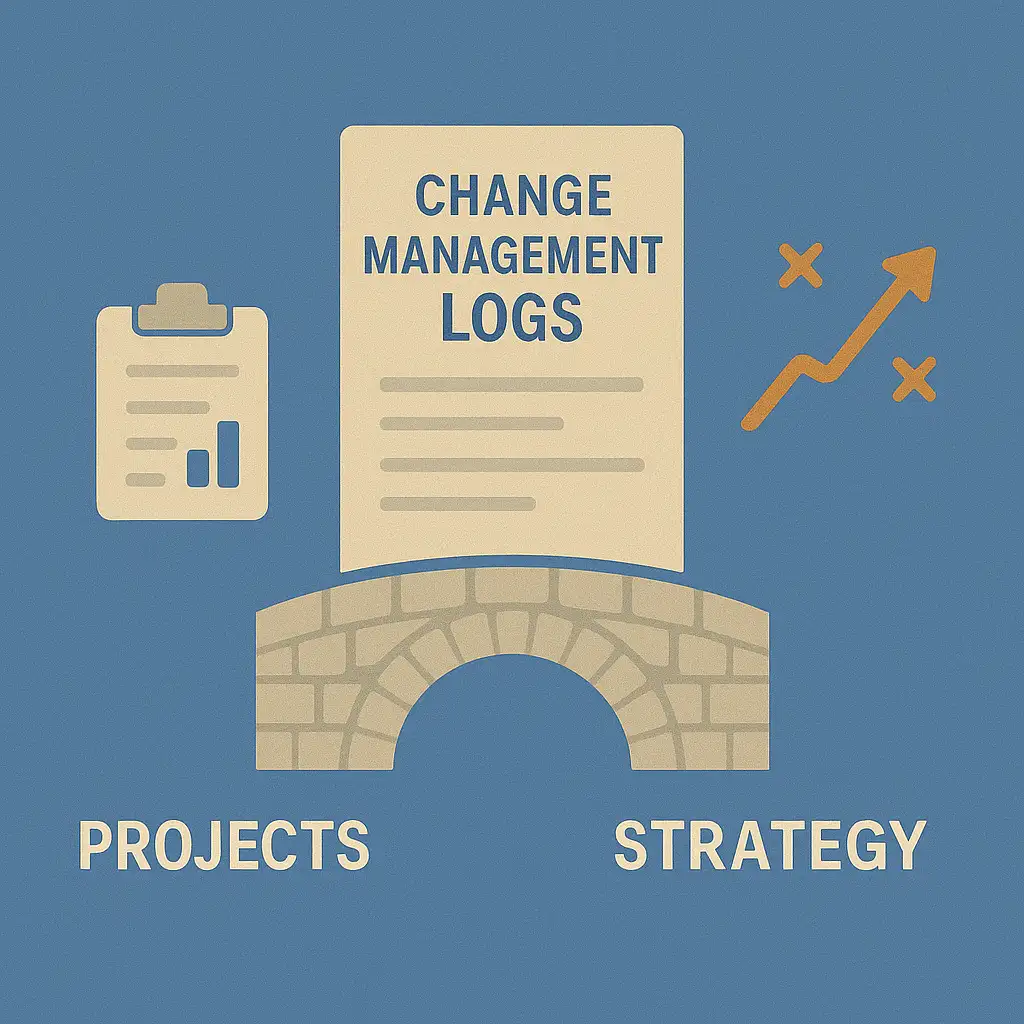Introduction to Change Management Logs
The ability to adapt and respond to changes is crucial for success. One of the key tools that facilitate this adaptability is the change management log. This document serves as a systematic record of all notable changes made throughout the lifecycle of a project, encompassing updates, decisions, and adjustments that impact project execution. By documenting these changes, organizations can ensure transparency, accountability, and effective communication among stakeholders, which are essential for navigating the complexities of project management.
Defining Change Management Logs
Change management logs are vital components of project management that track and document changes, ensuring that all modifications are recorded in a clear and chronological format. They not only capture the specifics of what changes were made but also provide context regarding why these changes were necessary. This documentation is crucial for maintaining a comprehensive understanding of the project’s evolution and for facilitating informed decision-making among team members and stakeholders [3][11].
Relevance of Change Logs to Organizational Strategy
The significance of change management logs extends beyond individual projects; they play a pivotal role in aligning project execution with broader organizational strategies. By systematically documenting changes, organizations can analyze how these adjustments impact strategic objectives, resource allocation, and overall project alignment with the company’s goals. This connection between project-level changes and strategic planning enables executives and strategic planners to make data-driven decisions that enhance organizational performance and ensure that projects contribute effectively to long-term objectives [4][12].
Effective Change Management for Better Project Outcomes
Implementing an effective change management process, supported by comprehensive change logs, can lead to improved project outcomes. When changes are documented and communicated effectively, teams can respond more swiftly to challenges, minimize disruptions, and maintain focus on project goals. Furthermore, a well-maintained change log fosters a culture of transparency and collaboration, allowing stakeholders to stay informed and engaged throughout the project lifecycle. This proactive approach not only mitigates risks associated with change but also enhances the likelihood of achieving desired project results, ultimately bridging the gap between project execution and organizational strategy [5][13][15].
Understanding Change Management in Projects
Change management is a critical aspect of project management that ensures the successful implementation of changes while minimizing disruption. A well-structured change management log serves as a vital tool in this process, bridging the gap between project execution and organizational strategy. Here are some key insights into the change management process and its significance.
The Change Management Process
The change management process typically involves several key stages:
- Identification: This initial phase involves recognizing the need for change, which can stem from various sources such as stakeholder feedback, project performance metrics, or shifts in organizational strategy. A change management log helps document these identified changes, providing a clear record of what needs to be addressed [10].
- Assessment: Once a change is identified, it must be assessed for its potential impact on the project and the organization. This includes evaluating the risks, benefits, and resource requirements associated with the change. A change log can facilitate this assessment by tracking the details and implications of each proposed change [10].
- Approval: After assessment, changes must be approved by relevant stakeholders. This step is crucial as it ensures that all parties are aligned and that the change is in the best interest of the project and the organization. The change management log serves as a reference point for approvals, documenting who approved what and when [10].
- Implementation: The final stage involves executing the approved changes. This requires careful planning and communication to ensure that all team members understand their roles in the implementation process. A change log can help monitor the progress of these changes, ensuring that they are integrated smoothly into the project workflow [10].
Common Challenges in Managing Change
Managing change within projects can present several challenges, including:
- Resistance to Change: Team members and stakeholders may resist changes due to fear of the unknown or discomfort with new processes. Effective communication and involvement in the change process can help mitigate this resistance [4].
- Lack of Clarity: Without a clear understanding of the change and its implications, team members may struggle to adapt. A well-maintained change management log can provide clarity by detailing the reasons for the change and its expected outcomes [10].
- Alignment with Strategic Goals: Ensuring that project changes align with broader organizational strategies can be difficult. A change log can help track how each change contributes to strategic objectives, making it easier for executives and strategic planners to see the bigger picture [10][11].
Importance of Aligning Project Changes with Strategic Goals
Aligning project changes with organizational strategy is essential for several reasons:
- Enhanced Decision-Making: When project changes are aligned with strategic goals, decision-makers can prioritize changes that offer the most significant benefits to the organization. This alignment ensures that resources are allocated effectively and that projects contribute to overall business objectives [11].
- Improved Accountability: A change management log provides a transparent record of changes and their alignment with strategic goals, fostering accountability among project teams and stakeholders. This transparency can enhance trust and collaboration within the organization [10].
- Sustained Organizational Growth: By ensuring that project changes support strategic initiatives, organizations can foster a culture of continuous improvement and adaptability. This alignment helps organizations remain competitive and responsive to market changes [11].
The Structure of a Change Management Log
A change management log serves as a vital tool that connects project execution with broader organizational strategy. It not only tracks changes but also ensures that these changes align with the strategic goals of the organization. Below are the essential components and structure of an effective change management log, along with insights on categorizing changes and the importance of documentation.
Essential Elements of a Change Management Log
An effective change management log should include the following key elements:
- Change Description: A clear and concise summary of the change being proposed or implemented. This should detail what the change is and why it is necessary.
- Impact Analysis: An assessment of how the change will affect the project, including potential risks, benefits, and implications for stakeholders. This analysis helps in understanding the broader impact on organizational strategy and project objectives.
- Approval Status: A record of whether the change has been approved, rejected, or is pending approval. This is crucial for maintaining accountability and ensuring that all changes are formally sanctioned.
- Change Category: A classification of the change as minor, major, or strategic. This categorization helps in prioritizing changes and understanding their significance in relation to project goals and organizational strategy.
- Date of Change: The date when the change was proposed and when it was approved or implemented. This timeline is essential for tracking the progress of changes over the project lifecycle.
- Responsible Parties: Identification of individuals or teams responsible for implementing the change. This ensures accountability and clarity in roles.
- Documentation Links: References to any supporting documents or additional information related to the change, such as meeting notes or detailed reports.
Categorizing Changes
Changes can be categorized into three main types:
- Minor Changes: These are small adjustments that have minimal impact on the project scope, timeline, or budget. They can often be implemented quickly and with little formal approval.
- Major Changes: These changes significantly affect the project and require thorough analysis and approval. They may alter project deliverables, timelines, or resource allocation.
- Strategic Changes: These are high-level changes that align with organizational strategy and objectives. They often require executive approval and have far-reaching implications for the organization as a whole.
Importance of Documentation and Traceability
Documentation and traceability are critical components of a change management log. They provide:
- Accountability: A well-documented change log ensures that all changes are tracked and that responsible parties are held accountable for their implementation. This accountability is essential for maintaining project integrity and trust among stakeholders.
- Transparency: Clear documentation allows all stakeholders to understand the rationale behind changes, fostering a culture of transparency within the organization.
- Historical Record: A change management log serves as a historical record of all changes made throughout the project lifecycle. This can be invaluable for future projects, as it provides insights into what changes were effective and how they were managed.
- Alignment with Strategy: By documenting changes and their impacts, organizations can ensure that project execution remains aligned with strategic objectives, bridging the gap between day-to-day operations and long-term goals.
Linking Change Management Logs to Organizational Strategy
Change management logs are essential tools in project management that serve to bridge the gap between project execution and organizational strategy. By systematically documenting changes throughout the lifecycle of a project, these logs provide critical insights that can align project outcomes with strategic objectives. Here are several key points illustrating how change logs can effectively connect project execution to broader organizational goals:
- Visibility into Project Impacts: Change management logs offer a transparent view of how specific project changes affect strategic objectives. By recording alterations in project scope, timelines, and resources, organizations can assess the implications of these changes on their strategic goals. This visibility allows executives to understand the direct correlation between project activities and organizational performance, ensuring that projects remain aligned with the overarching strategy [10].
- Informed Strategic Planning and Decision-Making: Tracking changes through management logs not only aids in monitoring project progress but also informs strategic planning. By analyzing the data captured in change logs, executives can identify trends, challenges, and opportunities that arise during project execution. This information is invaluable for making informed decisions about resource allocation, prioritization of initiatives, and adjustments to strategic plans. For instance, if a project is consistently facing delays due to resource constraints, this insight can prompt a reevaluation of resource distribution across projects to better align with strategic priorities [12].
- Case Studies of Successful Alignment: Numerous organizations have successfully utilized change management logs to align their projects with strategic goals. For example, a multinational corporation implemented a change log system that documented all project modifications and their impacts on strategic objectives. By regularly reviewing these logs, the leadership team was able to pivot their project focus in response to market changes, ensuring that their initiatives supported the company’s long-term vision. Another case involved a non-profit organization that used change logs to track adjustments in their community outreach projects. This tracking enabled them to align their efforts with evolving community needs, ultimately enhancing their strategic impact [11][14].
Benefits of Utilizing Change Management Logs
Change management logs are essential tools in project management that serve to connect project execution with broader organizational strategies. By documenting and tracking changes, these logs not only facilitate effective communication but also enhance decision-making processes and ensure strategic alignment. Here are some key benefits of implementing change management logs:
- Improved Communication: Change logs provide a centralized repository for all change requests and their statuses, which enhances communication among project teams and stakeholders. This transparency ensures that everyone is on the same page regarding project modifications, reducing misunderstandings and fostering collaboration [1][9].
- Enhanced Decision-Making: With a comprehensive record of changes, project managers and executives can make informed decisions based on historical data and the impact of previous changes. This data-driven approach allows for better evaluation of proposed changes, ensuring that the value justifies any potential impact on the project’s budget, schedule, and quality [12][10].
- Strategic Alignment: Change management logs help ensure that all changes align with the organization’s strategic goals. By documenting how each change contributes to or detracts from these objectives, organizations can maintain focus on their overarching mission while adapting to necessary adjustments in project execution [10][6].
- Risk Mitigation: Implementing change logs can significantly reduce risks associated with project changes. By systematically tracking and evaluating change requests, organizations can identify potential issues early on and develop strategies to address them. This proactive approach minimizes disruptions and helps maintain project timelines and budgets [5][14].
- Fostering a Culture of Transparency and Accountability: Change logs promote a culture of transparency by providing visibility into the decision-making process surrounding changes. This openness encourages accountability among team members, as everyone understands the rationale behind changes and their implications for the project. Such a culture not only enhances team morale but also builds trust among stakeholders [1][15].
Best Practices for Implementing Change Management Logs
- Change management logs serve as a vital link between project execution and organizational strategy, ensuring that changes are documented, evaluated, and aligned with broader business objectives. For executives and strategic planners, implementing effective change management logs can enhance decision-making and improve project outcomes. Here are some actionable recommendations to establish a robust change management log process:
Establish a Structured Change Request Process:
- Begin by creating a formal process for submitting change requests. This should include a standardized change request form that captures essential details such as the description of the change, reasons for the change, potential benefits, estimated costs, and impact on the project and organization [10].
- Each change request should be assigned a unique identifier for easy tracking, which helps maintain clarity and accountability throughout the project lifecycle [4].
Train Team Members on Change Management Best Practices:
- It is crucial to provide training for team members on change management principles and best practices. This training should cover the importance of maintaining a change log, how to document changes effectively, and the procedures for reviewing and approving change requests [12].
- By fostering a culture of awareness and understanding around change management, organizations can reduce resistance and enhance buy-in from team members, ultimately leading to smoother project execution [14].
Utilize Tools and Software for Change Management Logs:
- Implementing the right tools can significantly streamline the process of maintaining change management logs. Consider using project management software that includes features for tracking changes, such as Asana, Trello, or Microsoft Project. These tools can help automate the logging process and provide real-time updates on change requests [15].
- Additionally, utilizing collaborative platforms like Confluence or SharePoint can facilitate communication and ensure that all stakeholders have access to the latest information regarding changes, fostering transparency and informed decision-making [15].
Regularly Review and Update Change Logs:
- Establish a routine for reviewing and updating change logs to ensure they remain current and relevant. This includes assessing the impact of changes on project timelines, budgets, and overall strategic goals [11].
- Regular reviews can also help identify patterns in change requests, allowing executives to make informed decisions about resource allocation and project prioritization in alignment with organizational strategy [12].
Communicate Changes Effectively:
- Comprehensive communication is essential for successful change management. Ensure that all stakeholders are informed about changes and their implications for the project and the organization as a whole. This can be achieved through regular updates, meetings, and reports that highlight key changes and their strategic relevance [13].
By following these best practices, executives and strategic planners can effectively implement change management logs that not only enhance project execution but also align with and support the organization’s strategic objectives. This approach not only mitigates risks associated with change but also fosters a proactive culture that embraces adaptability and continuous improvement.
Conclusion
Change management logs serve as a vital link between the execution of projects and the overarching organizational strategy. These logs not only document changes throughout the project lifecycle but also provide a structured approach to tracking milestones, deliverables, and key decisions. By maintaining a comprehensive change management log, organizations can ensure that every adjustment made during a project aligns with their strategic objectives, thereby enhancing overall coherence and effectiveness.
The critical role of change management logs can be summarized as follows:
- Alignment with Strategy: Change logs facilitate a clear connection between project activities and strategic goals, ensuring that every change contributes to the organization’s vision and mission. This alignment is essential for maximizing resource utilization and achieving desired outcomes [10][14].
- Standard Practice Adoption: For executives and strategic planners, adopting change management logs as a standard practice is not just beneficial but necessary. By institutionalizing this practice, organizations can foster a culture of transparency and accountability, which is crucial for navigating the complexities of project management [10][15].
- Enhanced Project Alignment: Implementing change management logs can significantly enhance project alignment with strategic goals. This practice allows for real-time adjustments and informed decision-making, ultimately leading to more successful project outcomes and a stronger organizational strategy [10][12].
In conclusion, the integration of change management logs into project management processes is a strategic imperative. Executives and strategic planners are encouraged to embrace this tool to bridge the gap between project execution and organizational strategy effectively. By doing so, they can ensure that their projects not only meet immediate objectives but also contribute to long-term strategic success.
Find out more about Shaun Stoltz https://www.shaunstoltz.com/about/.
This post was written by an AI and reviewed/edited by a human.



